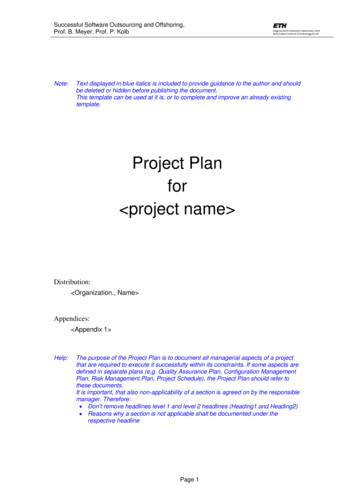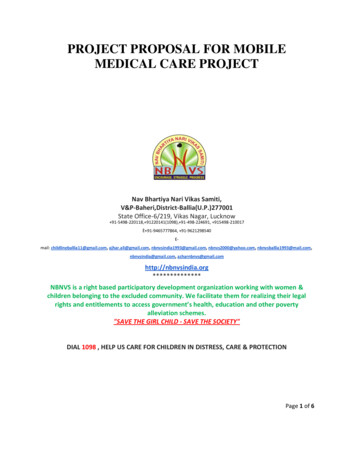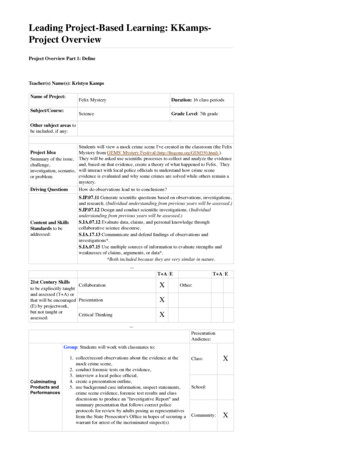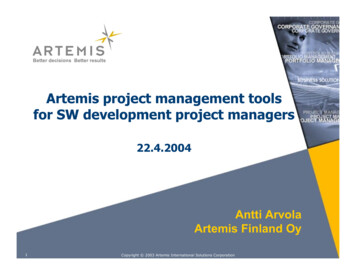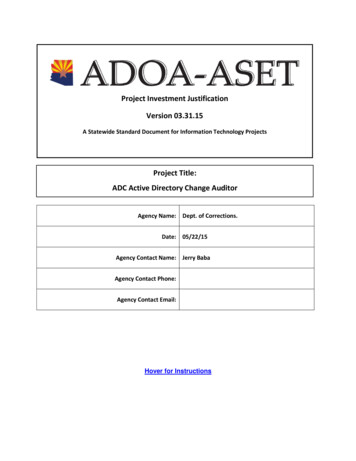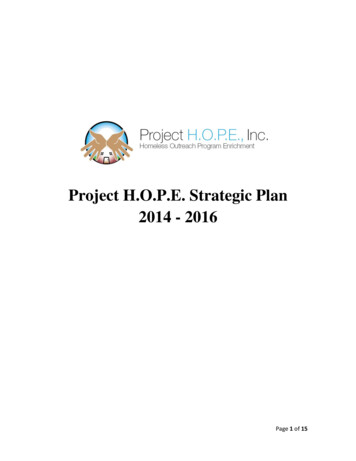
Transcription
Project H.O.P.E. Strategic Plan2014 - 2016Page 1 of 15
Project H.O.P.E. 2014 – 2016 Strategic PlanTable of ContentsExecutive Summary. 3Mission Statement . 4Stakeholders . 4Mandates . 4Plan Development. 4SWOT Analysis. 5Strengths . 5Weaknesses . 6Opportunities . 6Threats . 7Goals . 7Goal 1: Fundraising Development. 7Goal 2: Provide Behavioral and Substance Abuse Health Care Services . 7Goal 3: Increase Community Involvement and Awareness . 8Goal 4: Improve HRSA Compliance . 8Goal 5: Recruit and Retain 5 Patient Representatives on Board. 8Goal 6: Improved Clinical Outcomes. 9Accomplishments 2010-2013 . 9Strengthen Governance . 9Develop Project H.O.P.E. Staff and Succession Plan . 9Increase Community Awareness and Involvement . 10Create a New Clinical Facility for Project H.O.P.E. . 10Integrate Primary Medical Care with Behavioral Health Care Services . 10Maintain and Improve Organizational Sustainability . 10Appendix A: HRSA’s 19 Requirements for FQHCs . 12Appendix B: References . 15Page 2 of 15
Executive SummaryDear Project H.O.P.E. Community Members,It is with pleasure that we introduce Project H.O.P.E.’s 2014 Strategic Plan. As the new benefits of theAffordable Care Act become effective, Project H.O.P.E. looks for ways to improve access to care andmodify workflow to improve the health and well-being of our patients. Our map to future improvementis captured in our Strategic Plan. This plan represents the culmination of over a year of planningactivities: bringing together Project H.O.P.E. stakeholders to evaluate the needs of our patientpopulation, the community and our organization and to strategize on how to take advantage of currentopportunities, and most importantly to continue to provide high quality medical care and social servicesfor homeless and at risk individuals throughout the Camden area.This plan is a living document that will be routinely evaluated and updated to take advantage of newconcepts, technologies, and to adapt to internal and external conditions. Since the release of ourStrategic Plan 2010–2013, much has been achieved, much has been learned, and much has changed. Wehave received federal funding to construct a new facility to better serve our increasing number ofpatients, we have transitioned completely to an Electronic Health Record (paperless), and we havebegun to functionally realign our model of care to integrate primary care and behavioral health services.With the Strategic Plan 2014–2016 we are preparing the organization for the future by changingworkflows to create a Patient Centered Medical Home model of care in a new facility that will result inimproved access to care and improved clinical outcomes for our patients.This planning process comes at a critical time for Project H.O.P.E. Even as millions of Americans gainaccess to insurance coverage under the Affordable Care Act, Project H.O.P.E. and other health centersrecognize that there are millions who remain without access to a primary health care physician,according to a report by the National Association of Community Health Centers. At this time of struggleand opportunity, it is critical for Project H.O.P.E. to determine how to serve the evolving needs of ourcommunity through increasing organizational effectiveness and strategizing for the future. ThisStrategic Plan outlines our goals to deliver and maintain excellent primary care for the population thatwe serve.As you read, I invite you to continue to work together with Project H.O.P.E. to better serve andstrengthen our community. I would like to take this opportunity to thank all of the Project H.O.P.E.stakeholders, including current patients, Board Trustees, staff members, and volunteers, whocontributed to the strategic plan. We could not have done it without you!Sincerely,Patricia DeShieldsCEOPage 3 of 15
Mission StatementThe Board of Trustees adopted the following mission statement on May 18, 2010:The mission of Project H.O.P.E. is to improve the health and well-being of homeless personsand others in need within the greater Camden, New Jersey area by providing primary,preventative and related health care services.This statement serves as the public representation of Project H.O.P.E.’s goals and methodology as wellas a guide and internal compass for the Project H.O.P.E. staff and governing boards.For the past twenty years Project H.O.P.E. has fulfilled its mission by assisting more than 11,000homeless persons in their journey to permanent housing and self-sufficiency. Project H.O.P.E. is uniquein that it is the only provider of medical services specifically for the homeless in Camden County and oneof five Federally Qualified Health Center (FQHC) homeless projects in New Jersey.Project H.O.P.E. currently operates a full time health center providing culturally sensitive comprehensiveprimary health care serving patients at three locations: its main site, Bergen Lanning Health Center, asatellite center at the Camden City Volunteers of America site, and through its Mobile Health Van whichtakes health care, mental health and substance abuse services to the streets and points where homelesspeople gather in Camden.StakeholdersProject H.O.P.E. stakeholders include patients, staff members, volunteers, Board Trustees, fundingagencies, donors, organizational partners, Community Advisory Board (CAB) members, localgovernment, public officials, neighbors, the Camden area community, local health providers, and localhomeless service providers.MandatesThe Bureau of Primary Health Care (BPHC) under the Human Resources Service Administration (HRSA) ofthe United States government has defined nineteen key requirements that must be met in order tooperate and receive funding as a Federally Qualified Health Center (FQHC). These requirements relateto defining need, breadth of services, management and services, and governance. In order to remain anFQHC, Project H.O.P.E. must continue to be in compliance with the requirements, which are listed inAppendix A as summarized by the BPHC. Through striving to fulfill its mission in the most responsibleand efficient manner, Project H.O.P.E. will simultaneously be working to meet the 19 BPHCrequirements prescribed by HRSA and included in Appendix A.Plan DevelopmentThe following resources were used to develop Project H.O.P.E.’s strategic plan:Page 4 of 15
Review of progress on 2010-2013 Strategic Plan goalsProject H.O.P.E. Online Survey completed by 66 people including 18 staff, 4 board members, and 41consumers between September and October 2013.Facilitated SWOT Discussion with Board and staff on July 18, 2013.Needs Assessments including:o Project H.O.P.E.’s 2013 Homeless Needs Assessment: 205 surveys completed between June20 and July 9, 2013 including 137 at Project H.O.P.E. and the remainder at Cathedral Kitchen,Neighborhood Center, Oasis, Co-Star, and Camden’s Farmer’s Market.o Monarch Housing Associates: Southern New Jersey Regional Homeless Assessment Report,2012o Camden County, NJ - CHNA Final Summary Report 2013SWOT AnalysisTo inform the development of this strategic plan, Project H.O.P.E. completed a Strengths, Weaknesses,Opportunities and Threats (SWOT) analysis. The SWOT analysis is based on the results of the ProjectH.O.P.E. Online Survey and the Facilitated SWOT Discussion.Strengths 98.48% of Project H.O.P.E.’s online survey respondents indicated that Project H.O.P.E.’s “missionaccurately represents the organization's work.”Project H.O.P.E.’s Street Outreach Team brings services to the homeless, provides referrals foravailable resources and follows up with medically and socially complex patients to make sure theyare obtaining appropriate and timely care.Provide health services via mobile van throughout service area every day Monday through FridayStaff is committed, diligent, competent and uses existing resources very wellBoard is dedicated, committed and diverseEvery patient is treated as an individual with unique needs and everyone feels valuedTraining opportunities offered to Board membersImprovements in Clinical Performance Measures 2012 – 2014 including:o Diabetes (Percentage of patients with a A1c is less than 9)o Hypertension (Percentage of patients with a BP less than 140/90)o Cervical Canter (Percentage of women who received a Pap Test)o Began Tobacco Use and Assessmento Began providing Tobacco CounselingOrganizations such as New Jersey Patient Care Association and the National Health Care for theHomeless Council provide great learning opportunities, resources and best practicesFiscally soundLong history of HRSA making sure that FQHCs remain open and operationalSmall staff allows organization to change direction and implement changes quickly and nimblyDue to geographic size of Camden and regional transportation, services are accessible to patientsPage 5 of 15
Weaknesses Board retention is an issue and existing workload on individual Board members hinders growthopportunitiesStruggle to attract, retain and support a strong Clinical and Administrative workforce due to inabilityto provide adequate base salaries and raisesProject H.O.P.E. is challenged with recruitment and retention of clinical and administrative staffwhich impacts our ability to provide timely, comprehensive primary health care services.o Project H.O.P.E. has made considerable improvements in base salaries since 2012, buthigher salary and benefit packages at other health centers, hospitals and medicalpractices in the area remains a contributing factor to recruitment and retention.o Another significant contributing factor to retention is the stress associated withproviding care to a special population.Staff is at risk of exposure to high levels of stress because they devote so much time and energy tohelping clients obtain needed medical care, housing, and social services. As a result, we see the signsand symptoms of stress which are strongly associated with absenteeism and increased staffturnover.Do not do enough fundraisingWait time for walk in patients remains longDo not provide sufficient opportunities for Board to meet outside of meetings with each other andwith staff to get to know each otherNo capital planning process has been developedOpportunities New facility will:o increase patient capacity and improve patient flowo allow space for on-site services such as mental and substance abuse services, improvingpatient continuity of careo include dedicated community space for Project H.O.P.E. and partner organizations tohold events and meetingso generate positive public relations and increase visibility in the communityo improve patient privacy and staff moraleImplementing latest best clinical practices to improve services to the poor including:o National Committee of Quality Assurance (NCQA) clinical standardso National Health Care for the Homeless Council (NHCHC) Recommendations for the Care ofHomeless Patientso NHCHC Treatment and Recommendations for Patients who are Homeless with Diabeteso NHCHC Treatment and Recommendations for Homeless Patients with Hypertension,Hyperlipidemia & Heart FailureImplementing regulatory requi
SWOT Analysis To inform the development of this strategic plan, Project H.O.P.E. completed a Strengths, Weaknesses, . o Hypertension (Percentage of patients with a BP less than 140/90) o Cervical Canter (Percentage of women who received a Pap Test) o Began Tobacco Use and Assessment o Began providing Tobacco Counseling Organizations such as New Jersey Patient Care Association File Size: 778KBPage Count: 15




